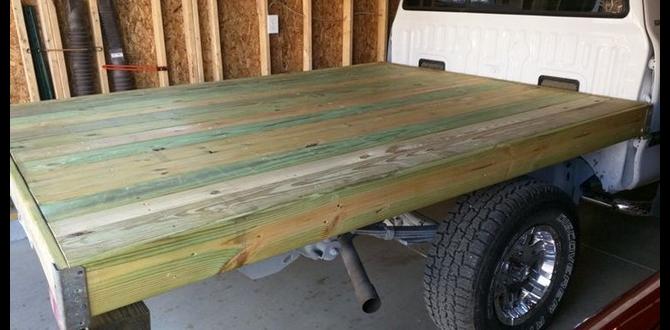Have you ever wanted to create something special for your truck? A wood bed can be a great way to do just that. Building a wood bed for your truck is not only fun but also practical. Imagine feeling proud every time you load up your gear. Sounds amazing, right?
Many truck owners find that a wooden bed adds character and function. Plus, you can customize it to fit your style! Did you know that a well-built wood bed can increase your truck’s usability? It’s true! People use their trucks for many reasons, from camping trips to work projects, and a good bed makes everything easier.
This DIY guide will walk you through the steps to build a wood bed for your truck. Whether you are a beginner or have some experience, you can do this! Let’s dive in and turn your truck into something truly yours.
Table of Contents
How To Build A Wood Bed For A Truck: Diy Guide Explained

How to Build a Wood Bed for a Truck: DIY Guide
Building a wood bed for your truck can be fun and rewarding. With simple tools and materials, you can create a custom fit for your needs. Start by measuring your truck bed accurately. Then, choose the right type of wood for durability. After securing the wood pieces together, finish with weatherproofing for extra protection. Did you know a well-built wooden truck bed can enhance both style and functionality? Get ready to impress your friends and make transporting items easier!Choosing the Right Materials
Types of wood suitable for truck beds. Choosing between treated and untreated lumber.Picking the right wood for your truck bed is like choosing the perfect ice cream flavor—it’s important! Softwoods like pine are lightweight and affordable, but may not last long under heavy use. Hardwoods like oak are sturdy but can be pricey. Now, should you go for treated or untreated lumber? Treated wood has chemicals that help it resist rot and bugs, making it tough like a superhero. Untreated wood is more natural but may not hold up as well. So, choose wisely!
| Type of Wood | Pros | Cons |
|---|---|---|
| Pine | Lightweight, cheap | Less durable |
| Oak | Strong, durable | Expensive |
Essential Tools for the Project
List of tools needed for building a wood bed. Safety equipment and best practices.Building a wood bed for your truck is fun and straightforward. To get started, you’ll need some essential tools. Here’s a quick list:
- Saw: A circular or hand saw works well.
- Drill: Use it to make holes for screws.
- Measuring tape: Accurate measurements are key.
- Screwdriver: Needed for tightening screws.
- Sander: Smooth out rough edges for safety.
Don’t forget safety equipment! Wear gloves and goggles to protect yourself. Always follow best practices, like working in a well-lit area and keeping your tools organized. This makes building safer and easier!
What safety gear do I need?
For safety, wear gloves for hand protection and safety goggles to shield your eyes from dust and debris.
Measuring and Designing Your Truck Bed
Understanding dimensions specific to your truck model. Sketching a design based on functionality and aesthetics.First things first, get the right measurements for your truck. Each truck model is different, so grab a tape measure and figure out your truck’s bed length and width. Don’t worry if you feel like a robot doing math—you’re just getting started! Next, sketch a design that shows what you want. Think about how the bed will look and what you’ll use it for. Get creative! Colorful drawings might even distract your friends from your terrible cooking skills. Use the table below to help organize your thoughts:
| Truck Model | Length (ft) | Width (ft) |
|---|---|---|
| Model A | 6 | 5 |
| Model B | 8 | 5.5 |
| Model C | 5.5 | 4.5 |
This way, you’ll have a clear plan to work from. Remember, a well-planned design is the first step to building a bed that won’t just hold your junk; it will look good doing it!
Preparing the Truck Bed Area
Cleaning and clearing the truck bed. Inspecting the bed for existing damage.Before you start building a wooden bed for your truck, it’s time for a little spring cleaning! Clear out everything from the truck bed. Dust bunnies don’t make great companions. Inspect the bed for any lumps, bumps, or nasty cracks. If it looks like it survived a battle with a raccoon, fix it up first. Remember, a smooth bed means a happy bed, and happy beds make for less squeaking on the road!
| Task | Description |
|---|---|
| Cleaning | Remove all items and sweep out debris. |
| Inspecting | Look for cracks and dents. Repair any damage. |
Building the Wood Frame
Stepbystep instructions for creating the frame structure. Reinforcement techniques for durability.Start by measuring your truck bed’s size. Cut four wooden boards to this length. Next, make a rectangle with these pieces. Use screws to hold them together tightly. For extra strength, add corner braces. This keeps the frame sturdy. Don’t forget to sand the edges. This prevents splinters and makes it safer.
How do I reinforce the wood frame for durability?
To make your frame last long, use these tips:
- Use thicker wood: It gives better support.
- Add diagonal braces: They help prevent wobbling.
- Secure with heavy-duty screws: They hold better than nails.
Well-built frames can last for years!
Assembling the Wood Bed Panels
Cutting dimensions for the wood panels. Techniques for attaching wood panels to the frame.First, grab your trusty measuring tape! Measure and cut the wood panels according to these sizes: 48 inches for width and 72 inches for length. Remember, the wood doesn’t grow back, so measure twice and cut once! To attach them to the frame, you can use screws or brackets. Consider a fun tip: use a power drill and pretend you’re a superhero. It will make you feel powerful while keeping everything tight! Here’s a simple table for your sizes:
| Panel Type | Width (inches) | Length (inches) |
|---|---|---|
| Side Panels | 48 | 72 |
| Front/Back Panels | 72 | 48 |
Attaching securely means less wobble while you’re driving; nobody wants a bumpy ride! So get ready to assemble your dream truck bed like a pro!
Finishing Touches and Protective Treatments
Sanding and sealing the wood for longevity. Options for paint, stain, or protective coating.After crafting your wood bed, it’s time for the final touches! Start with sanding; this makes the wood smooth and pleasant to touch. No one wants splinters during a road trip! Next, choose a protective treatment. You can paint, stain, or use a clear coat. Each option has its pros and cons, so pick one that fits your style. Here’s a simple table to help you decide:
| Option | Pros | Cons |
|---|---|---|
| Paint | Colorful and hides imperfections | May chip over time |
| Stain | Enhances wood grain | Needs reapplication |
| Clear Coat | Strong protection | Can darken wood |
Sealing your wood will keep it safe from the elements. Remember, a little care goes a long way. Your truck bed will thank you with lasting beauty!
Installation Tips and Final Adjustments
Securing the wood bed to the truck. Adjusting for optimal fit and stability.To keep your wood bed secure, use heavy-duty screws to attach it to the truck frame. Start by drilling pilot holes in the wood. Then, drive in screws to hold everything tight. Next, check for gaps. You want the bed to fit snugly against the truck. Use rubber spacers for extra support.
- Check for any wobbles.
- Adjust the height if needed.
- Make sure all screws are tight.
Finally, take a test drive. Feel how the bed holds up. This way, you’ll know it’s ready for use!
What are some tips for securing the wood bed?
Use strong screws and check for a tight fit. Adjust as needed to prevent shaking while driving.
Maintenance for Longevity
Routine checks and minor repairs. Tips for preserving the wood bed over time.To keep your wood bed strong, check it often. Look for cracks, holes, or signs of wear. Small fixes can help avoid big problems later. You can sand rough spots and fill small holes to keep it smooth.
Here are some tips for lasting wood beds:
- Use a wood sealer to protect from water.
- Avoid heavy weights that can bend the wood.
- Park in shaded areas to prevent sun damage.
How can I make my wood bed last longer?
Regular checks and using the right protective treatments will extend the life of your wood bed. Keeping it clean and dry is also key.
Conclusion
In conclusion, building a wood bed for your truck can be fun and rewarding. You’ll need basic tools and materials to get started. Follow simple steps to create a sturdy design that fits your truck perfectly. Don’t forget to measure twice and cut once! For more tips and detailed guides, keep exploring DIY resources. Happy building!FAQs
What Materials Are Needed To Build A Wood Bed For A Truck?To build a wood bed for a truck, you need some important materials. First, you’ll need sturdy wood boards, like plywood or lumber. Then, get screws to hold the wood together. You may also need brackets for extra support. Don’t forget tools like a saw, drill, and measuring tape to help you build!
How Do I Measure And Cut The Wood Properly For A Truck Bed?To measure and cut wood for a truck bed, first, you need to measure the size of the truck bed. Use a tape measure to get the length and width. Write down these numbers so you remember them. Next, mark the wood with those measurements. Finally, carefully cut along the lines with a saw. Always wear safety gear!
What Tools Are Essential For Constructing A Wooden Truck Bed?To build a wooden truck bed, you need a few strong tools. First, get a saw to cut the wood to the right size. Next, a drill will help you make holes and connect the pieces. You’ll also need a hammer and nails to hold everything together. Lastly, measuring tape will help you make sure everything fits just right!
How Do I Ensure That The Wooden Bed Is Properly Secured To The Truck?To make sure the wooden bed is safe on the truck, you should use strong straps or ropes. First, place the bed flat in the truck. Then, loop the straps over the bed and tie them tight. Check to see if everything is secure before you drive. Always be careful to keep it from moving!
Are There Any Tips For Treating Or Weatherproofing The Wood Used In A Truck Bed?You can treat wood in a truck bed by using special wood sealant. This helps keep water out and stops the wood from rotting. You should also clean the wood often to remove dirt. Applying a coat of oil or varnish will also protect it. Don’t forget to check for any damage and fix it quickly!






